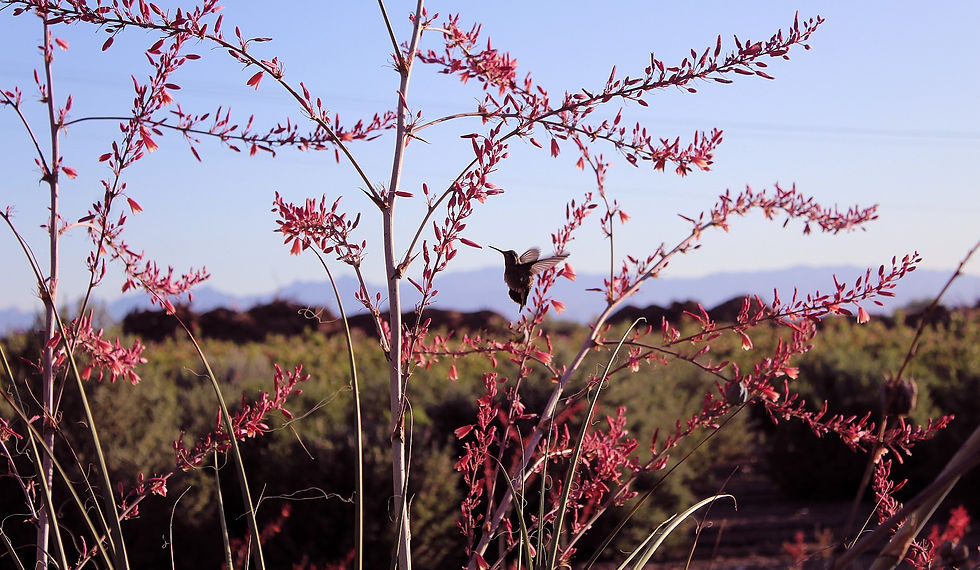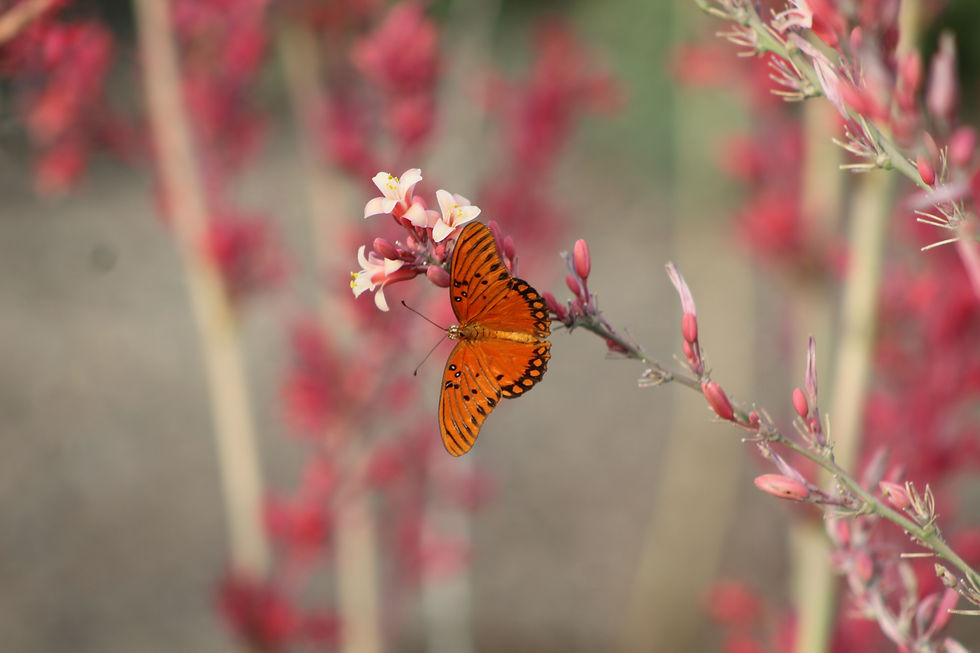Designing with Little Giant Hesperaloe: Big Impact, Small Footprint
- Shawna Coronado

- Aug 11
- 5 min read
When you want to make a big statement without overwhelming a space, Little Giant Hesperaloe delivers. This compact powerhouse is rapidly gaining attention among top landscape architects and garden designers. With its bold structure, low-water needs, and season-spanning flowers, Little Giant Hesperaloe is the perfect choice for designs focused on beauty, sustainability, and ease.

Let’s dive into why this plant deserves a place in your next project — whether you’re working in the desert Southwest, the Pacific Northwest, or anywhere between.
Table of Contents
What Makes Little Giant Hesperaloe Special?
At first glance, you’ll notice the strong, sculptural form of Little Giant Hesperaloe. A selection of Hesperaloe funifera, this variety was specially chosen for its compact size and bold texture. Unlike the standard form, which can sprawl aggressively over time, Little Giant stays tidy and dense.

It forms a thick rosette of deep green, sword-like leaves. Thin, curling white fibers decorate the leaf margins, adding even more visual interest. At maturity, this plant stays around 3-4 feet tall and wide, making it ideal for urban spaces, small gardens, and even container installations.
But the magic doesn’t stop there. In late spring through summer, Little Giant sends up sturdy, towering flower stalks lined with creamy white to pale green blooms. These flowers not only attract pollinators like hummingbirds and bees but also lend a graceful vertical accent to designs.
Little Giant Hesperaloe: A Low-Maintenance Dream
In today's landscapes, low-maintenance planting is king. Designers need plants that look good without constant care, especially in climates like the desert Southwest. Here’s where Little Giant Hesperaloe shines.
Drought Tolerant: Once established, it needs minimal supplemental water.
Heat and Cold Hardy: Performs well in the extreme heat of Arizona but also withstands surprising cold snaps.
Pest and Disease Resistant: Virtually no issues with common garden pests.
Long-Lived: This is an investment plant that will remain beautiful for years with little effort.
No Pruning Required: Just occasional removal of old flower stalks and dried leaves keeps it tidy.
For busy commercial sites, urban streetscapes, or water-conscious residential gardens, Little Giant Hesperaloe fits like a glove.

Best Growing Conditions for Little Giant Hesperaloe
While Little Giant is forgiving, it does have preferences that ensure peak performance:
Sun Exposure: Full sun is ideal. Partial shade is tolerable but may reduce flowering.
Soil: Well-drained soils are a must. It handles rocky, sandy, or even decomposed granite conditions with ease.
Water: Low water use once established. Water deeply but infrequently during establishment.
Spacing: Allow for a 4-foot diameter to give each plant room to showcase its full form.
In the Pacific Northwest or wetter Western states, make sure to place Little Giant Hesperaloe in raised beds or amend heavy soils to prevent root rot.

Designing with Little Giant Hesperaloe: Where It Shines
Urban and Commercial Landscapes
Little Giant’s compact footprint makes it a hero for urban landscapes. Think parkways, median strips, public plazas, and tight courtyards where space is limited but impact is essential.
Its clean, architectural look pairs especially well with modern design styles — concrete planters, steel edging, gravel mulch, and geometric layouts bring out its bold personality.
Residential Gardens
In residential settings, Little Giant is a perfect fit for water-wise front yards, entryway plantings, and xeriscape designs. It creates a strong year-round structure without the maintenance burden of lawns or fussy perennials.
Use it as a specimen, in mass plantings for a dramatic effect, or tucked into rock gardens for naturalistic scenes.
Container Gardens
Don’t overlook its power in containers! Little Giant Hesperaloe thrives in large pots. Place containers by patios, pool decks, or rooftop gardens for dramatic, low-care flair.

Partner Plants from Civano Growers: Perfect Pairings
To truly showcase Little Giant Hesperaloe, pair it with other plants that share its resilience and beauty. Here are some excellent companions from the Civano Originals collection:
Leucophyllum candidum ‘Microburst’ PP33437: This compact Texas Sage explodes with silvery foliage and bright lavender flowers after summer rains — a stunning contrast to Little Giant’s darker green blades.
Hesperaloe parviflora ‘Stoplights’ PP34195: Mix Little Giant with the fiery coral blooms of ‘Stoplights’ for a dynamic flowering combination that attracts pollinators.
Tecoma ‘Red Hot’ PP31610: For more color and hummingbird appeal, the bold red-orange blooms of ‘Red Hot’ Tecoma light up the landscape.
Dodonaea viscosa ‘Emerald Ice’ PP33514: This tough, evergreen shrub offers glossy green foliage with a hint of silver — a lush backdrop for Little Giant’s sculptural form.
Ericameria laricifolia ‘Butterbloom’ PP33157: For a fine-textured contrast, ‘Butterbloom’ adds vibrant yellow flowers and wispy stems.
These combinations allow designers to build dynamic palettes that thrive together in low-water environments.

Helpful Design Tips for Little Giant Hesperaloe
Repetition Builds Rhythm: Plant Little Giant in rhythmic groupings to guide the eye through a landscape.
Use Contrasting Textures: Pair with fine-leaved or airy plants to highlight Little Giant’s bold, clean lines.
Layer Heights Strategically: Place Little Giant in front of taller specimens or against structural elements like walls and boulders.
Choose Complementary Colors: Surround with silvery or purple foliage plants to make its deep green pop.
By using these strategies, you can maximize visual interest while keeping maintenance demands low.
Real-World Success: Little Giant in Action
Landscape architects have already embraced Little Giant Hesperaloe in high-profile projects. In Phoenix, it’s been used in downtown streetscapes where heat, reflective surfaces, and foot traffic challenge most plantings. Thanks to its compact form and resilience, it not only survives but looks immaculate year-round.
In the Pacific Northwest, designers are using Little Giant in courtyard gardens where drainage is improved and winter rains can be managed. Paired with gravel mulch and drought-tolerant perennials, it offers an exotic, sophisticated feel without clashing with cooler climates.

Final Thoughts: Small Size, Monumental Impact
When you design with Little Giant Hesperaloe, you bring more than just beauty to the table. You create lasting, sustainable landscapes that deliver bold style, minimal maintenance, and essential ecological benefits.
Whether you're filling medians, crafting water-wise gardens, or elevating private courtyards, Little Giant empowers you to make a big impact with a small footprint.
Ready to add the Little Giant Hesperaloe to your next project? Explore more options and companion plants at Civano Growers. Craft resilient, beautiful designs that stand the test of time — and look stunning while doing it.




Comments